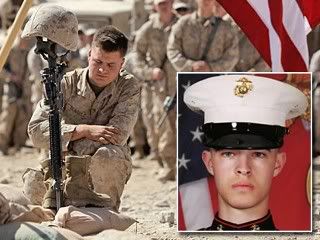Controversy is swirling around the Associated Press’s decision to publish a photograph of a 21-year-old Marine in his final moments of life.

Cpl. Braxton Russell pays tribute to Lance Cpl. Bernard during an August 27 memorial service in Afghanistan.
(Julie Jacobson, AP Photo, USMC)
Lance Cpl. Joshua M. Bernard was struck and fatally wounded by a rocket-propelled grenade during a Taliban ambush August 14 in the Helmand Province of Afghanistan, and the AP’s image shows Lance Cpl. Bernard being assisted by fellow Marines after sustaining these fatal injuries.
The controversy is not a new one, and the positions are stark. The AP’s position is that journalists have a public duty to show the realities of war, regardless of how unpleasant and brutal the coverage might be. Lance Cpl. Bernard’s family does not want their pain to be compounded by the publication of their loved one suffering in his final moments.
Santiago Lyon, the director of photography for the AP, stated:
AP journalists document world events every day. Afghanistan is no exception. We feel it is our journalistic duty to show the reality of the war there, however unpleasant and brutal that sometimes is. Our story and photos report on him and his last hours respectfully and in accordance with military regulations surrounding journalists embedded with U.S. forces.
Secretary of Defense Robert Gates weighed in on the controversy by siding with the family. Sec. Gates contacted Thomas Curley, president and chief executive officer of the AP, asking him to pull the photo rather than distributing it to its subscribers. Curley stepped back in reconsideration, but ultimately, he came down on the side of the public’s right to know. Sec. Gates responded:
I cannot imagine the pain and suffering Lance Corporal Bernard’s death has caused his family. Why your organization would purposefully defy the family’s wishes knowing full well that it will lead to more anguish is beyond me. Your lack of compassion and common sense in choosing to put this image of their maimed and stricken child on the front page of multiple American newspapers is appalling. The issue here is not law, policy or constitutional right – but judgment and common decency.
Earlier this year, Sec. Gates lifted the Dover Ban, and I applauded this move. I took that position for a couple of reasons. First, the images of coffins returning to America, though painful, doesn’t seem to compare to the horror of images of dying soldiers. Second, Sec. Gates made the release of images contingent upon the approval of the families of the fallen.
I will be the first to admit that I have a personal experience guiding my opinion on this controversy. When my brother-in-law Josh was killed while serving, the AP and other news outlets had immediate and 24-hour news coverage. In fact, my husband discovered his brother’s death through a media outlet before the military had even contacted his parents. Josh’s name had not been released, but the media covers so many details that having a name is often unnecessary. I have never watched those videos or searched out all the images. The one that I was able to post was hard enough, and I sit here in tears as I write this post. As I wrote then:
Josh’s body was broken and bleeding in that fire.
My situation differs from the Bernard family in two significant ways. Because Josh died on American soil, all the images were immediately available, and the circumstances of Josh’s death prevented any image from being too detailed. Additionally, journalists are required to notify families before posting pictures of their loved ones serving in war zones according to military guidelines.
From ABC:
The AP waited until after Bernard’s burial in Madison, Maine, on Aug. 24 to distribute its story and the pictures. An AP reporter met with his parents, allowing them to see the images.
Bernard’s father after seeing the image of his mortally wounded son said he opposed its publication, saying it was disrespectful to his son’s memory. John Bernard reiterated his viewpoint in a telephone call to the AP on Wednesday.
“We understand Mr. Bernard’s anguish. We believe this image is part of the history of this war. The story and photos are in themselves a respectful treatment and recognition of sacrifice,” said AP senior managing editor John Daniszewski.
The personal pain that I feel in having Josh’s death covered by the media certainly gives me deep empathy for the Bernard family. Yet, I also understand that the public has a right to know.
I am wary of anyone, especially the government, controlling the flow of information in the public arena. The Pentagon recently hired a disgraced PR firm to rate the coverage of the media on Afghanistan based on whether the news had a positive spin or not. I wrote about Nir Rosen, one of the reporters profiled by this firm, last October. I recognize that the situation in Afghanistan is tenuous at best and rapidly deteriorating at worst, and the journalists are the people’s front lines for information to speak out in our democracy.
Nevertheless, I am on the side of the Bernard family in that I believe that their wishes should have been respected, and I recognize that my empathy for them and my personal experience are what I have used to reach this conclusion. I believe that families should have the right to decide on images of their fallen loved ones in war.
But where do we draw the line? Who should control the publication of images? Does the public’s right to know and freedom of the press trump a grieving family? Or should military families be able to control the release of images of their loved one dying?
————————–
Please note: I have purposefully not included the AP’s controversial image (nor a link to the image) out of respect for Lance Cpl. Bernard’s family. I would ask that any comments please not include the image.
————————-
crossposted at Navy Blue Wife
27 comments